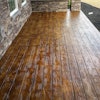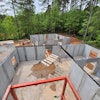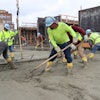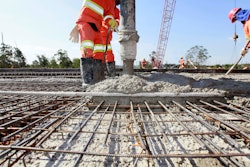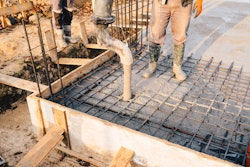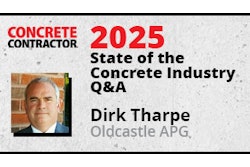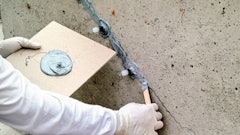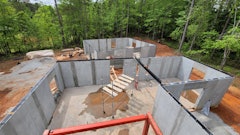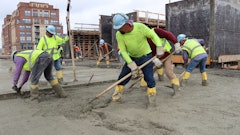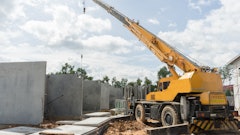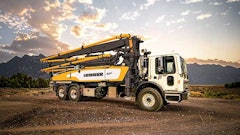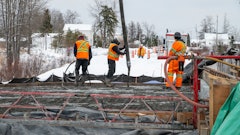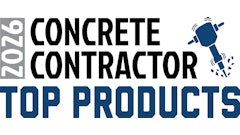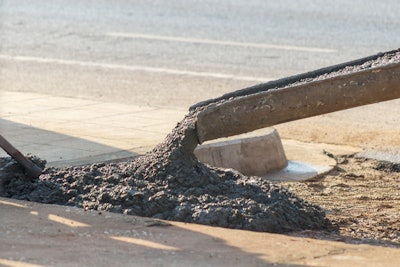
In 2025, not all concrete work is created equal; some segments are booming, others are pulling back.
Segments in concrete construction seeing growth are in infrastructure and civil projects; data centers and advanced manufacturing; and tilt-up and precast. Public funding, digital infrastructure needs, and long-term demographic shifts are fueling growth. Meanwhile, high interest rates, evolving work habits, and cautious developers are squeezing private-sector activity. In short, 2025’s concrete boom is led by megaprojects and public works, not strip malls or office towers.
Thanks to federal investment through programs like the Infrastructure Investment and Jobs Act, concrete work on highways, bridges, and public buildings is up. Public sector bids rose ~3 percent this year, fueling demand for road paving, barriers, and precast components. Civil and institutional work (schools, hospitals) remains strong, largely immune to interest rate pressures.
Data centers and advanced manufacturing construction is one of 2025’s hottest segments. Driven by the surge in AI, cloud services, and semiconductor production, concrete contractors specializing in tilt-up and foundation work are seeing a flood of demand. These high-tech facilities are capital-heavy and often use tilt-up panels and massive slabs, keeping contractors in this niche extremely busy.
Both tilt-up and precast are benefiting from the infrastructure and industrial boom. Tilt-up remains popular for data centers and logistics facilities, while precast is increasingly used in public projects like bridges and tunnels.
Contracting segments:
- Residential Construction - Single-family homebuilding slowed due to high mortgage rates, though multi-family and urban projects (with podium slabs and structured parking) held steadier. Some rebound is expected as rates ease.
- Commercial (Office, Retail, Hospitality) - Office and retail projects have slowed significantly. Remote work and e-commerce continue to reduce demand for new space, and high borrowing costs have chilled speculative development. Hospitality is recovering, but new hotel construction remains selective.
Let’s Look Forward
Heading into 2026, the concrete construction industry is set for modest growth, driven by infrastructure spending, tech-sector demand, and a possible rebound in residential work. 2026 looks like a year of steady, not explosive, growth, led by infrastructure and tech. Contractors who align with these sectors will stay busiest.
Growing Segments:
Infrastructure and public works will remain strong as federal funding from the Infrastructure Investment and Jobs Act hits peak implementation. Data centers and industrial facilities, powered by cloud computing and clean energy investments, are expected to stay active, though growth may slow slightly. Precast concrete is also expanding, driven by labor shortages and carbon-reduction goals. Civil paving remains solid, bolstered by climate-resilient design and DOT specifications.
Stabilizing Segments:
Tilt-up construction is plateauing at high levels, especially in logistics and light industrial builds. Developers favor its speed and labor efficiency, but overcapacity in warehousing could temper new demand. Single-family housing may slowly recover as interest rates ease, but growth will likely be regional. Parking structures are in decline as urban design shifts away from car dependency.
Lagging Segments:
Office, retail, and mid-rise urban developments are likely to remain sluggish due to financing hurdles, zoning delays, and shifting demand. However, incentives tied to low-carbon materials could jumpstart select urban projects.
On the Contractor Side
Today’s concrete contractors are adapting to inflation, high interest rates, and market volatility with sharper strategies, tighter operations, and smarter bids. Contractors aren’t just surviving economic challenges, they’re becoming leaner, smarter, and more strategic to maintain momentum and profitability.
- Smarter Bidding and Contracting
To protect margins, contractors are building inflation buffers into their bids and contracts. Escalation clauses, allowances, and contingency pricing have become common. Many are shifting from fixed-price to negotiated or cost-plus contracts, allowing flexibility if material or labor costs surge mid-project.
- Cash Flow is King
With borrowing more expensive, maintaining strong cash flow is essential. Contractors are negotiating faster billing cycles and milestone-based payments. To guard against payment delays, still a major issue, many firms are building cash reserves, keeping credit lines open, and exploring invoice factoring.
- Project Diversification
To stay resilient, contractors are branching out from volatile private-sector work into public infrastructure, industrial, and retrofit jobs. These markets, often backed by federal or institutional funding, offer more stability, helping contractors keep their backlogs healthy even when commercial real estate slows.
- Tech and Efficiency Gains
Facing rising costs, firms are turning to tech to stretch resources. Project management tools, drone mapping, prefabrication, and lean construction methods are helping cut waste, reduce overtime, and optimize schedules. Even fuel-saving fleet tech is being used to trim operating costs.
- Cautious Capital Spending
Due to high interest rates, many contractors are delaying major purchases. Instead of buying, they’re leasing or buying used equipment to avoid debt. When projects stall due to financing issues, contractors are helping clients “value engineer” alternatives to keep builds feasible.
Tariffs continue to put pressure on concrete contractors in 2025, with ripple effects across materials, project costs, and scheduling. On the material side, tariffs on steel, aluminum, and lumber have driven up prices for key materials like rebar and formwork. For example, Canadian lumber tariffs jumped from 14.5 percent to 34.5 percent, pushing up formwork costs significantly. Steel tariffs have had a similar effect on rebar. Many contractors report adding 8–10 percent to bids just to cover pricing volatility. According to ABC, 87 percent of contractors were notified of supplier price hikes directly tied to tariffs.
These cost surges have made some projects financially unviable. In April 2025, nearly 1 in 5 contractors reported delays or cancellations due to tariffs. One Midwest municipal project saw bids come in 15 percent over budget, forcing a pause and rebid. Fixed-price contracts have especially hurt smaller firms, who are now including escalation clauses to protect against tariff-induced hikes.
Adjusting to this, contractors are sourcing more materials domestically or from non-tariff countries, but this isn’t always cheaper. Rising demand for U.S.-made materials has created backlogs and new cost pressures. Some are shifting to alternatives like fiber reinforcement or composite forms, but these often require new approvals and training.
While there are signs tariffs may stabilize or even ease in late 2025, their current impact is undeniable: higher material costs, tighter margins, delayed projects, and complex sourcing decisions. Contractors are adapting with better risk-sharing in contracts and more strategic purchasing, but the environment remains challenging.
Planning for What’s Next
The economic forecast for the rest of 2025 and into 2026 suggests a “soft landing” scenario: slower but steady growth, easing inflation, and gradual relief from high interest rates. While concerns about a recession persist, most economists expect any downturn to be mild. Strong labor markets and public spending are acting as buffers, even as private investment slows due to higher borrowing costs.
Inflation has cooled significantly from the 2022 peak, and the Federal Reserve has begun lowering rates cautiously. More cuts are expected into 2026, which could revive private construction and make financing more accessible. For contractors, that means tighter conditions in 2025, but potential for project acceleration next year.
Public infrastructure and manufacturing builds remain strong, driven by federal investment. However, private residential and commercial sectors are still constrained by financing hurdles and developer caution. Growth in these areas may pick up in 2026 if interest rates ease further.
Contractors should expect a stable but subdued environment: slow growth, ongoing margin pressures, and selective project opportunities. Strategic bidding, tech adoption, and diversified portfolios remain critical. If rate cuts continue and global conditions improve, 2026 could offer a modest rebound.
The bottom line is there is no boom on the horizon but no bust either. Concrete contractors should prepare for cautious optimism and position themselves to move quickly when conditions improve.
This is part 2 of a 3-part series looking at the state of the concrete industry in 2025.

